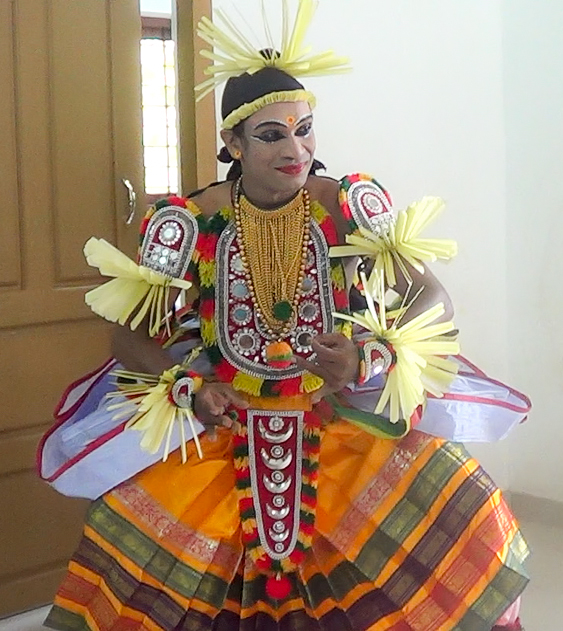What can the living practitioners of an art tell us that history books cannot? Helena Reddington offers a glimpse into how Tullal and its origins are understood by present-day artists.
Helena Reddington
Tullal is a satirical performance tradition from Kerala attributed to the poet Kunchan
The term ‘tullal’ literally means ‘to jump or leap about’, denoting the lively and dynamic movement of the performer. It is performed by solo artists combining elements of classical dance with Malayalam poetry, which is sung to music. The artists are supported by a mridangam drummer and a singer who plays the cymbals. Kunchan Nambyar’s 18th-century poetry continues to be used for Tullal performances to this day.
As one of the most important classical Malayali poets,
Over forty Tullal poems are attributed to Nambiar. These can be divided into three subgenres, each distinguished by the performer’s costume and style of rendering: Ottan Tullal (ഓട്ടൻ തുള്ളൽ), Parayan Tullal (പറയൻ തുള്ളൽ), and Sitankan Tullal (ശീതങ്കൻ തുള്ളൽ). However, there is no clear consensus on just how these names came to be used for the genres.
Academic studies, such as those of the Malayali scholar Evoor Parameshwaran 1, suggest that these names could have originally been characters from Padayaṇi (പടയണി), a folk tradition of Kerala. G. Girijadevi 2 has found evidence in
However, my fieldwork with Tullal artists in 2017 brought up an intriguing alternative interpretation which is unexplored in the academic literature on the tradition. In one of our meetings, Kalamandalam Janardhanan, a Tullal artist with over six decades of experience, was able to share invaluable insights about the possible etymology and origins of the subgenres.

Ottan Tullal is by far the most popular style, known for its fast-paced tempo and dynamic audience interaction. It is commonly understood that ‘Ottan,’ derives from the Malayalam verb ‘to run.’ However, Kalamandalam Janardhanan explained to me that ‘the Ottan’ actually refers to the mediator whose duty was to run and quickly convey the message of the king to the people.
Parayan Tullal is the most rarely performed style of the three. It is known for its slow-paced tempo as well as its philosophical and devotional themes. ‘Parayan’ can be derived from the Malayalam verb ‘to tell.’ Taking this a step further, however, Kalamandalam Janardhanan explained that ‘Parayan’ can be interpreted as ‘the person who only tells what is necessary.’ Interestingly, both interpretations of these subgenres seem to revolve around the common notion of communication and conveying certain ideas both quickly and concisely. It is perhaps possible to connect the meaning of these names to

Lastly, he explained that Sitankan Tullal actually refers to the Pulayar community of Kerala. Therefore, ‘Sitankan Tullal,’ which uses an intermediate tempo, can be understood as ‘the dance of the Pulayars.’ Again, there seems to be an interesting parallel between the etymology of the names Parayan and Sitankan Tullal, as both could potentially be references to the Dalit communities of Kerala. This is particularly intriguing given the evidence that Nambyar did appropriate elements from both ‘folk’ and temple performance traditions in the development of Tullal. Given Tullal’s hybrid origins that mix upper and lower caste traditions, it is very possible that these names do not have any singular meaning, but encompass multiple and many-layered meanings.
There is much we can learn from the insight and expertise of Tullal performers for a better understanding of Kunchan
References
- Parameshwaran, Eavoor. Nampyāruṃ tuḷḷalsāhityavuṃ [Nambyar and Tullal Literature]. Kottayam: National Bookstall, 1969.
- Girijadevi, G. Nampiyāruṭe śilpaśāla [Nambyar’s Craft]. Kottayam: Sahityapravarttaka Sahakaranasangham, 2014.
About the Author: Helena Reddington is a PhD candidate in the School of Religious Studies at McGill University, Canada. She is currently writing her dissertation on the Tullal performance genre. She can be contacted at helena.reddington@mail.mcgill.ca
